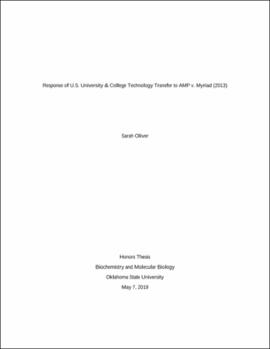| dc.description.abstract | The United States Patent and Trademark Office (USPTO) aims to stimulate and promote innovation, to strengthen the nation's industry and economy, and to maintain the United States' technological competitiveness on a global scale. One type of intellectual property protection offered by the USPTO is patents. Patent protection offers inventors a legal title to their innovation, as well as the right to exclude others from making, using, selling or importing their patented work for a term of 20 years. In exchange, the inventor agrees to publicly disclose information about their innovation. Prior to 1980, the patents of federally-funded research projects for small businesses and nonprofits, such as universities, were held by the U.S. government, resulting in billions of dollars of research innovation being unapplied for public use. The Bayh-Doyle Act marked a shift of patent titles and licensing responsibilities away from the government to the federally-funded research entities. This shift caused exponential growth in industrial innovation and "technology transfer" at academic institutions. In particular, patents of "natural products" skyrocketed in volume for the field of biotechnology. However, a string of Supreme Court decisions in the early 21st century, particularly the highly publicized Association for Molecular Pathology v. Myriad Genetics, Inc., cast new uncertainty on the patentability of natural products. This study briefly reviews the patenting landscape of biotechnology leading up to Myriad and aims to provide greater insight as to the effects of the Supreme Court's decision at the level of academic research institutions, as perceived by surveyed members of the Association of University Technology Managers (AUTM). Statistically significant results were achieved on data in the following six areas: (1) demographics of survey respondents, (2) patenting behaviors post-Myriad, (3) attitudes toward patenting (in general), (4) attitudes toward Myriad, (5) the use of certain patenting strategies post-Myriad. However, there was insufficient survey response on section (6)—attitudes toward those same strategies (perception of their effectiveness)— to make claims from the data. | |
